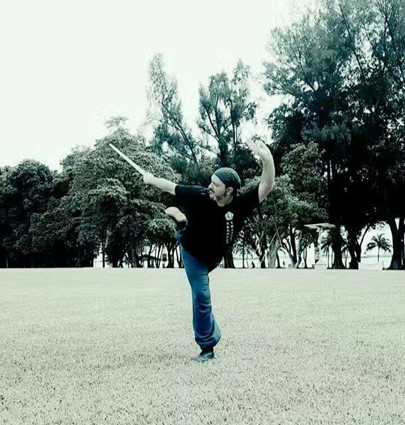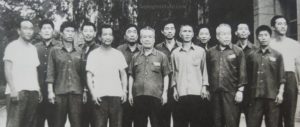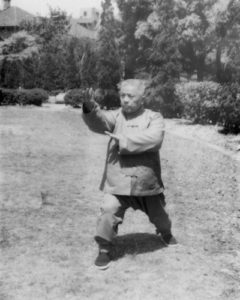Of the many sword methods within the Taiping Institute, there are three significant systems including Wudang Sword, Qingping Sword and Qimen Sword which all share Daoist origins or influences. Qimen (奇门 ) which is reference to ancient Daoist divination. Qimen Sword, often also known as Qimen 13 Sword (奇门十三剑), Qimen Bagua Sword (奇门八卦剑) Ending Life 13 Swords (绝命十三剑) or simply as 13 Sword (十三剑) has two legends of origin. The first is based on the Qimen Dunjia, a type of Daoist metaphysics that was used in ancient hsitory to help with military strategy (e.g. during the Warring States period and supposedly used in the battle of Red Cliff). During the Ming dynasty, Liu Bowen (1311-1375) was a well known military strategist who applied the method in supporting Zhu Yuanzhang in the rebellion against the Yuan Dynasty, thereby securing the throne for the ’Hongwu’ emperor. Qi Men Dun Jia is based on astronomical observations, and consists of various aspects of Chinese metaphysics, including the doctrines of yin and yang, five elements, the eight trigrams, the ten Heavenly Stems and the twelve Earthly Branches, as well as the twenty-four solar terms. There are a number of martial methods based on it’s themes such as Qimen Sword (奇门剑), Qimen Spear (奇门枪) and Qimen Staff(奇门棍). In the central plains areas (Shandong, Hebei, etc) the cradle of Chinese civilization is where the martial arts were developed to an advanced level and many methods integrating the concepts from chinese culture and belief systems were established.
Due to the fame of general Qi Jiguang (戚继光), in later history (mostly propagated during the Nanjing Central Martial Arts Academy), the sword was also named in his honour as Qi (戚门剑) Men Sword. Qi Jiguang (1528-1588) originally from Shandong, a devout Daoist, was a Chinese military general of the Ming Dynasty, best known for leading Ming forces to defend China’s east coastal regions from raids by the Japanese pirates in the 16th century and is widely regarded as a national hero in Chinese culture. Qijiguang’s forefather served as a military leader under Zhu Yuanzhang and died in battle afterwhich the Qi family remained within the military for generations. As the foundation of the sword method is based on 13 key sword principles (e.g. Ce, Pi, Liao, Jian, Yun, Gua, Mo and so on) then combined through various configurations of the Qimen, which consists of San Qi (Sun, Moon & Stars) and Ba Men (Eight gates) that allow for 1,080 different configurations. The complete system consists of three sequences (San Qi), sometimes referred to as Sun, Moon and Stars (Ri, Yue, Xing) or Heaven, Earth and Man (Tian Di Ren), in accord with the Daoist cosmology. There are altogether over 145 techniques. The advanced practices of Qimen Sword include the study of the mystical Shield formations and the hidden set of practice that is found through unlocking the Qimen square within the existing routine. The Nanjing Central Martial Arts Academy (中央国术馆, 1928-1948) adopted a simplified set of the first sequence of Qimen Jian into its curriculum as well which helped spread the first routine across different styles, into Taiwan and beyond. The full Qimen Sword system however was kept within some of the family lineages of Meihuazhuang, Taizu Chang Quan and Chuojiao Men.




